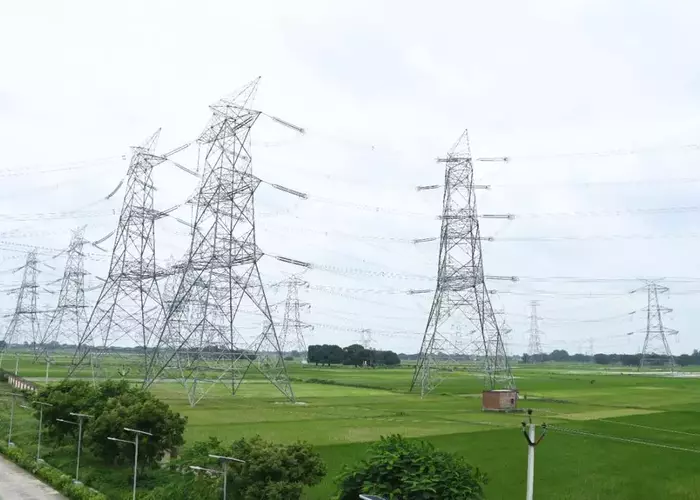

Transmission lines ferrying electricity over long distances (Representational Image)
Kathmandu: The government authorities from Nepal and India have agreed to build two new high capacity cross-border transmission lines, providing momentum to the ongoing bilateral cooperation in the field of energy.
Such an understanding was reached between the two countries during the 10th meetings of the Joint Steering Committee (JSC) at the secretary level and Joint Working Group (JWG) at the joint secretary level held on Feb.17-18 in Mount Abu, Rajasthan, India, officials said.
The authorities, in their talks, dwelt on the joint development of generation projects in Nepal, joint development of cross-border power transmission infrastructure, power trade under respective domestic regulations and policy framework, and capacity building assistance.
Madhu Bhetuwal, a spokesperson for Nepal’s Energy Ministry who attended the meetings, said that Nepal and India have agreed to build two new 400 KV capacity cross-border transmission lines within next six years.
According to Bhetuwal, the first is a 400kV transmission line connecting Nepal’s Duhabi city with Purnia of the Indian State of Bihar. The second one is a 400kV transmission line connecting Nepal’s New Lamki (Dodhara) with India’s Bareli.
This was the first meeting held at the level of energy secretary between Nepal and India after the formation of Prachanda-led new government in December last year.
Irrespective of change of guard in Kathmandu, power sector cooperation between Nepal and India is expected to go smoothly.
Prime Minister Prachanda’s first visit to India, which is still being worked out at the diplomatic level, is expected to give momentum to bilateral power sector cooperation.
The two sides also reached various understandings on cross-border power trade including enhancing the capacity of existing, under-construction and proposed transmission lines.
During the meetings which concluded on Saturday, officials also agreed to increase power import and export capacity from existing 600 megawatt to 800 megawatt through Dhakebar-Muzaffarupur 400 KV transmission line.
“The two sides also agreed to import and export 70 to 80 megawatts of electricity from Tanakpur-Mahendranagar 132 KV power transmission. A joint technical team will explore options for exporting up to 200 megawatts of electricity as well,” Bhetuwal told India Narrative over phone.
The Indian side, during their meeting, said that it was positive towards signing an inter-governmental agreement to export electricity generated from hydroelectric projects in Nepal to the Indian market.
The Indian side also gave positive response to Nepal’s request to export its surplus energy to Bangladesh via India. “India will facilitate exporting 50 megawatts of electricity to Bangladesh from Nepal. For this, Nepal will send a specific proposal to India in near future,” Bhetuwal further said.
Apart from other understandings, the two sides also agreed to set up a bilateral mechanism to export power from Nepal to the Indian state of Bihar during the rainy season through the existing 132 KV transmission line.
Both the parties also agreed on the early completion of the construction work of the Indian section of the 400 KV new Butwal-Gorakhpur transmission line as the second international transmission line by March 2025.
Cooperation in the field of energy has gained momentum between Nepal and India in recent years. The erstwhile government led by Sher Bahadur Deuba awarded at least two hydropower projects to Indian companies.
To deepen cooperation in power sector, the two neighboring countries issued a long-term vision titled “India-Nepal Joint Vision Statement on Power Sector Cooperation” during the official visit of former Prime Minister Deuba to India in April 2022.
During the visit, Nepal invited Indian companies to invest in the development, construction and operation of viable renewable power projects, including in the Hydropower sector in Nepal, focusing on storage-type projects.
In August last year, the Investment Board of Nepal signed a Memorandum of Understanding (MoU) with India’s National Hydroelectric Power Corporation (NHPC) Limited to develop the West Seti and Seti River (SR6) projects. This was earlier being developed by China. There are other India-supported projects including the 900 MW Arun-3 hydroelectric project which are under construction.
Nepal is rich in water resources with a combined potential to generate more than 42,000 hydroelectric power, according to studies.
(Santosh Ghimire is India Narrative’s Nepal correspondent based in Kathmandu)
The Defence Research and Development Organisation has offered 28 of its designed and developed weapon…
Nepal Foreign Minister Arzu Rana Deuba announced that 11 Nepali nationals being evacuated from Iran…
On June 21, 2025 (BST), Sikyong Penpa Tsering from the Central Tibetan Administration received a…
Strengthening maritime cooperation in the Indian Ocean Region, INS Teg, a frontline stealth frigate of…
Union Minister Hardeep Singh Puri paid tributes to the victims of the Kanishka bombing and…
The Baloch Yakjehti Committee marked three months since the arrest of the organisation's leaders such…